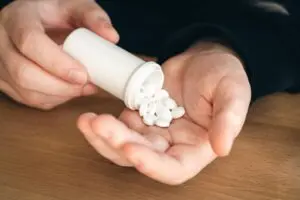The statistics are sobering – more than 106,000 people died of a drug-related overdose in 2021. Of those, roughly 70,000 deaths involved synthetic opioids, described by the Centers for Disease Control and Prevention as primary fentanyl. That’s almost a 7.5-fold increase in that category from 2015 to 2021.
And it doesn’t look like this deadly wave will crest and recede anytime soon, as fentanyl continues to flow without much impedance across our southern border. To show you how much we’re talking about, U.S. Customs and Border Protection fentanyl seizures last year totaled just over 14,000 pounds. In just six months of this fiscal year alone, fentanyl seizures have already reached 13,800 pounds. That’s an incredible 93% year-over-year increase in the amount seized each month.
Our nation’s fentanyl problem differs somewhat from other drug abuse crises in that this particular substance is vastly more lethal, and there’s only a small margin between a therapeutic dose and an overdose. The Drug Enforcement Agency considers just 2 milligrams of fentanyl a potentially fatal amount, while officials estimate that 1 kilogram (2.2 pounds) could kill roughly 500,000 people. Fentanyl takes effect quickly and usually leads to rapid and potentially deadly suppression of the central nervous system.

(pvproductions/Freepik)
What Is Fentanyl?
Fentanyl is a laboratory-made narcotic used for severe pain control in a medical setting. It mimics the pain-relieving effects of natural opioids like morphine, opium, and heroin. Doctors generally prescribe fentanyl only for post-surgical or cancer patients, as it is a Schedule II narcotic and thus has a high potential for abuse. Regarding effectiveness, fentanyl is about 100 times more potent than morphine.
Unlike other prescription drugs, however, one can easily obtain fentanyl because foreign drug cartels worldwide have discovered inexpensive methods to produce and distribute it through Mexico and into the United States. Illicit fentanyl can appear as nasal sprays, powders, and pressed pills that look like legitimate medication.
Closer to Home Than You Think
Fentanyl is everywhere, and just like other drugs, it does not discriminate by socio-economic status, race, gender, or intent. An overwhelming majority of the overdose deaths we mentioned at the beginning of this article resulted from using synthetic opioids, namely fentanyl, with other drugs. Since it is such a potent narcotic and extremely cheap to produce, dealers and users often combine fentanyl with other drugs to amplify the substance’s effects at a fraction of the cost.
We added the word ‘intent’ above because even for those who don’t consciously choose to buy fentanyl, the drug has essentially turned using any substance into a game of Russian Roulette. More often than not, people have absolutely no idea whether the product they’re getting will contain a lethal dose of fentanyl. Something as innocuous as your son or daughter purchasing an Adderall from a friend to get them through finals or borrowing a roommate’s sleeping pills could unexpectedly cut their lives short.
The problem is that young people don’t usually think fentanyl poisoning can happen to them. Many of these kids are not necessarily loitering on distant street corners, talking to shady-looking characters. They are dealing with their friends, peers, or sometimes even a trusted adult to get what they want – a pain pill, a quick hit, or some powder to take the edge off. And chances are their supplier has no idea whether the product they’re selling has fentanyl in it, either.
How to Protect Yourself and Your Loved Ones
“The onus rests with parents, educators, community members, church leaders, and other responsible adults to tackle the fentanyl crisis head-on, or we risk losing thousands more lives,” said Preston Dixon, COO of Renaissance Ranch, a substance abuse recovery center in Utah and Idaho. “We all can, and should, take action in one way or another,” he added. Some of his suggestions include:
Communicate, Cooperate, and Collaborate
We can actively participate in an ongoing national conversation about the dangers of fentanyl within our families, communities, and statehouses. Unfortunately, as long as there is a demand for drugs, bad actors around the world will continue to supply them. The fundamental differences will come about as we work to solve complex societal issues that get people involved with drugs in the first place, e.g., poor home life, past abuse, mental disorders, and the glorification of alcohol and drugs on various digital and media platforms.
You may not think you have a large sphere of influence, but that’s not necessarily true. Consider your friends and acquaintances across social media, the people in your office, your network of professional associations, people you know in your church congregation, your book club, etc. You probably cast a wider social net than you realize.
Another excellent way to combat fentanyl and other drug abuse in your community is to volunteer with advocacy groups like Partnership to End Addiction and Community Anti-Drug Coalitions of America. If you have a psychology or social work background or a history of dealing with drug abuse, you might also consider working with an addiction recovery center in your area.
On a more personal level, be open and accessible to your family members, especially your children. Let them know that you love them and that they can always come to you for help and guidance no matter what they’re doing. Ask them what they know about fentanyl, clear up any misconceptions, and teach them to be wary of accepting any pills or other drugs from anyone.
If You See Something, Do Something
You represent the best set of eyes and ears in your community. Have you noticed liquor stores or vape shops selling to minors? How about frequent foot and vehicle traffic in and out of a home or other location on your block? Did you come across an unusual odor on your neighborhood walk? If you observe suspicious activity, document it – write down physical descriptions, times, dates, license plate numbers, and other information that will help local law enforcement.
Take advantage of reporting your information on an anonymous tip line if you’d rather not deal directly with the police. Or, you can provide your police department narcotics unit with the data you have compiled and your suspicions. Either way, let the professionals handle the case from that point.
Another good idea is to involve community policing organizations, like neighborhood watch groups. Let them know what you’re seeing around your area. They can assist you in raising awareness in the community, disseminating essential information, and working with the police.
Familiarize Yourself with Local Addiction Resources
Several groups stand ready to help you or your loved one if addiction enters your life. Accessing professional recovery services, including medication-assisted treatment, as soon as possible will lessen your chances of becoming a victim of fentanyl-laced drugs.
It’s a good idea to determine whether your community offers Alcoholics and Narcotics Anonymous meetings, church-led addiction recovery support groups, and public and private drug treatment facilities. Knowing this information will help you become a reliable resource for those in your neighborhood, yourself, and your loved ones.
You don’t have to face addiction alone. If you’re struggling with substance abuse, please call 855-736-7262 and talk with one of our staff members.
